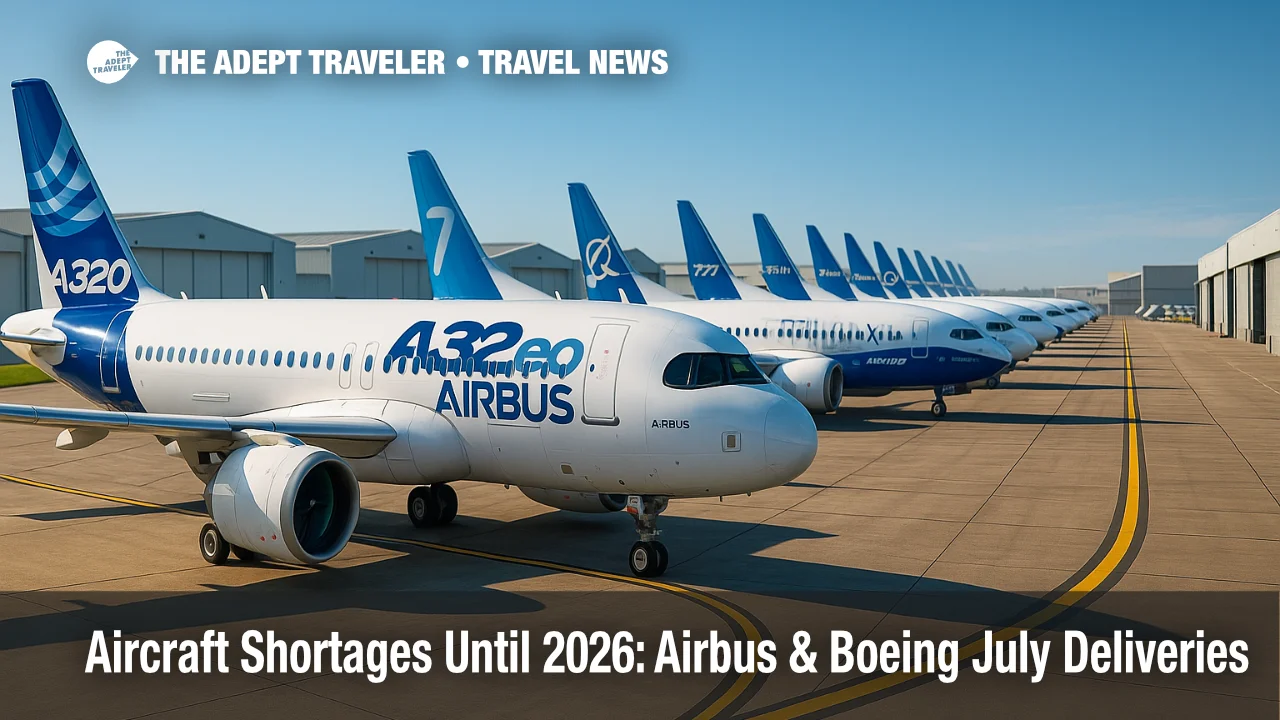Aircraft Shortages Through 2026: Airbus 62 jets, Boeing 47 Deliveries in July

Airbus and Boeing handed over just 109 commercial jets in July. The modest tally, coupled with swollen order books and lingering supply chain snags, signals that airlines will remain capacity constrained well into 2026-an outlook that points to persistently high leisure fares.
Key Points
- Why it matters: Deliveries still trail demand by double-digit percentages, limiting seat growth.
- Travel impact: Scarcer capacity lets carriers keep summer-style pricing deep into shoulder seasons.
- What's next: Even planned rate hikes leave a decade-long order mountain, so lessors and older jets stay in vogue.
Snapshot
Forecast International estimates Airbus delivered 62 aircraft last month, while Boeing shipped 47. Combined, that is barely over 100 jets, far below the 160-plus monthly pace needed to clear today's backlogs within ten years. Airbus alone sits on 8,754 unfilled orders; Boeing holds more than 5,900. At July's run-rate the duo would need more than a dozen years simply to honour existing contracts, even before new sales are booked.
Background
Pandemic-era factory slowdowns, quality crises at key suppliers, and a chronic shortage of skilled labour have hobbled both manufacturers since 2020. Boeing is capped at 38 MAX frames per month by U.S. regulators, while Airbus struggles to stabilise A320neo output at 50 jets and has 60 finished airframes parked without engines. Over the past two years airlines also parked hundreds of Pratt & Whitney-powered A320neos for lengthy turbine inspections, squeezing available lift even further.
Latest Developments
Delivery pace still trails backlog math
July's 109 deliveries equate to roughly 1,300 aircraft on an annualised basis. Against a combined backlog of about 14,650 jets, that output would take more than eleven years to grind down-longer if persistent supply bottlenecks on engines, seats, and avionics add fresh delays. Airbus has already warned clients that delivery lags could stretch "another three years," chiefly on engines and cabin interiors.
Shortage ripple boosts aftermarket, fares
The jet deficit is spilling over into parts and maintenance. Honeywell says demand for spares is surging as airlines keep ageing aircraft flying, a direct windfall from the lack of new metal. Consulting firm Sven Carlson Aviation notes ticket prices climbed by double-digit percentages in 2024 and show "similar rises" looming in 2025 as carriers ration seats.
Analysis
Even if Airbus realises its goal of lifting A320neo output to 75 per month by 2026 and Boeing gains regulatory blessing to push the 737 line to 52, the math still falls short. A combined narrow-body rate of 127 frames monthly would yield roughly 1,500 single-aisles a year-barely enough to cover natural fleet replacement, never mind growth. Wide-body recovery remains slower, with Airbus producing seven and Boeing ten twin-aisles monthly only by 2026. Add in hundreds of jets sidelined for Pratt & Whitney inspections and the effective capacity gap widens. All of this constrains seat supply just as IATA projects 4.9 billion passengers in 2025, up 5 percent year-on-year. Low-cost and leisure-focused airlines, which rely on volume pricing, will protect margins by trimming schedules rather than slashing fares, while legacy carriers keep premium cabins full. Lessors, flush with cheap capital, will continue to command higher lease rates for late-model aircraft, feeding costs back into ticket prices. With the world's largest leasing firms warning of shortages "to the end of the decade," travellers should not bank on a quick return to pre-pandemic bargain fares.
Final Thoughts
July's modest delivery figures underscore an uncomfortable truth: the factory spigot cannot reopen fast enough to meet post-pandemic travel demand. Until production, engines, and interior components align-and that now looks unlikely before 2026-aircraft shortages will keep capacity tight and leisure airfares elevated. Savvy travellers should lock in deals early or consider shoulder-season trips to dodge peak-price pressure driven by the ongoing aircraft shortages.
Sources
- Airbus and Boeing July 2025 Production Rates and Unofficial Deliveries, Forecast International
- Half-Year 2025 Results, Airbus
- Boeing Reports Q2 2025 Results, Boeing
- Inside the airline seat industry crisis delaying jet deliveries, Reuters
- Honeywell raises 2025 forecasts on jet-parts demand, Reuters
- Travel industry facing five years of increased flight prices, Hospitality Investor
- Aircraft lessors warn jet delays will stretch to decade-end, Reuters
